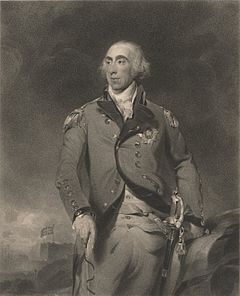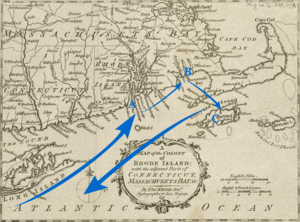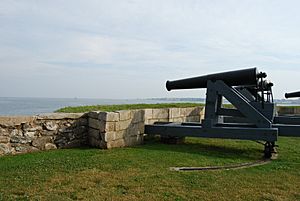Grey's raid facts for kids
Quick facts for kids Grey's raid |
|||||||
|---|---|---|---|---|---|---|---|
| Part of the American Revolutionary War | |||||||
 Major General Charles Grey (portrait by Joseph Collyer) |
|||||||
|
|||||||
| Belligerents | |||||||
| Commanders and leaders | |||||||
| Israel Fearing (Fairhaven) | Charles Grey, 1st Earl Grey | ||||||
| Strength | |||||||
| minimal (New Bedford and Martha's Vineyard) 150 (Fairhaven) |
4,000 troops | ||||||
| Casualties and losses | |||||||
| 4 killed 16 captured |
Entire expedition: 1 killed 4 wounded 16 missing |
||||||
In September 1778, Major General Charles Grey led a British attack. His troops raided the Massachusetts towns of New Bedford, Fairhaven, and Martha's Vineyard. This event was part of the British efforts during the American Revolutionary War. It was one of the first in a series of raids the British carried out on American coastal towns between 1778 and 1781.
General Grey's force had 4,000 soldiers. They were first meant to help the British troops who were under attack in Newport, Rhode Island. However, they arrived after the American forces had already left. General Sir Henry Clinton, a British army officer, then decided to use Grey's troops for raiding instead.
On September 5 and 6, Grey's forces attacked New Bedford and Fairhaven. They faced strong resistance only in Fairhaven. In New Bedford, the British destroyed many storehouses, ships, and supplies. The local militia offered little resistance there. In Fairhaven, the militia had more time to get ready, so the British caused less damage. After these raids, Grey sailed to Martha's Vineyard, which had no defenses. Between September 10 and 15, the islanders had to give up 10,000 sheep and 300 oxen. They also lost most of their weapons.
Contents
Why the Raid Happened
In December 1776, British forces took control of Newport, Rhode Island. American troops in New England were not strong enough to remove them. The British navy also used Newport as a base, making it even harder to attack.
Things changed in 1778 when France joined the war. France and America agreed to work together against the British. The French sent a fleet of ships led by Admiral comte d'Estaing. This fleet was meant to provide soldiers and naval support.
The French fleet arrived near New York City in July 1778. But the port was well-defended. Admiral d'Estaing also thought the water was too shallow for his biggest ships. So, he sailed to Newport instead. There, he and General John Sullivan planned to surround the British troops.
To protect Newport, General Sir Henry Clinton ordered 4,000 men under General Charles Grey to get ready. At the same time, Admiral Lord Richard Howe sailed from New York to fight d'Estaing.
On August 10, d'Estaing sailed out of Newport's harbor to battle Howe. As the two fleets moved into position, a big storm hit. It scattered and damaged both fleets. D'Estaing then decided to leave Newport and sailed to Boston for repairs.
American Retreat and New Orders
Meanwhile, General Sullivan had already started attacking Newport without French help. This made Clinton order Grey's force to sail for Newport on August 26. Clinton went with them. However, strong winds slowed their journey. They finally reached Newport on September 1. By then, the Americans had already left the island after the Battle of Rhode Island on August 29, 1778.
Instead of landing his troops at Newport, Clinton decided to do something else. His orders from March 1778 included attacking coastal towns. He was told to destroy shipbuilding places and supplies. So, he ordered the fleet to sail to New London, Connecticut. But he found too few ships there to make a landing worthwhile. He then told Grey to "proceed without loss of time to the eastward." This meant Grey was to raid New Bedford and Fairhaven in Massachusetts, and the island of Martha's Vineyard.
Attacks on New Bedford and Fairhaven

Early on September 4, Grey's fleet sailed into Buzzards Bay. The Royal Navy frigate Carysfort led the way. They met Lord Howe's fleet, and he agreed to stay near Block Island until the raids were done.
The Carysfort reached Buzzards Bay that afternoon. It hit rocks twice, but neither incident was serious. The fleet then went up the Acushnet River towards New Bedford and Fairhaven. That evening, Grey landed his soldiers at Clark's Point on the west side of the river.
Destruction in New Bedford
The troops spent the night and the next morning destroying ships, warehouses, and docks. They burned everything "in the whole Extent of the Accushnet River." Many of the destroyed ships were "prizes." These were ships captured by privateers, who were private ships allowed to attack enemy vessels, operating from the two towns.
The British set many ships on fire. The huge fire also destroyed homes and churches. It was so bright that people in Newport, about 20 miles (32 km) away, could see it. A small fort on the Fairhaven side of the river, now called Fort Phoenix, had 38 artillery soldiers. They fired at the British ships that evening. Then, they broke their fort's guns and left, but left their flag flying. The British fired back briefly and then destroyed the fort's guns.
Fairhaven's Defense
Grey's troops marched around the head of the Acushnet River. They camped on the eastern banks. The next day, they got into their boats. General Grey decided that Fairhaven should also be raided. At the same time, local militia began to arrive to defend Fairhaven. Major Israel Fearing took command from an older colonel who did not want to fight actively.
The British approached Fairhaven on the morning of September 6. Major Fearing placed about 150 men between the village and where the British would land. The British set fire to a few nearby buildings and then headed for the village. At this point, Fearing's men fired a strong volley of musket shots. The British quickly retreated to their boats.
Raid on Martha's Vineyard
Grey sent his helper, Captain John André, to New York. He asked for ships to carry livestock. Then, Grey sailed for Martha's Vineyard. Strong winds slowed the fleet's journey. They did not reach the harbor at Holmes Hole (now Vineyard Haven) until September 10. Because of the bad winds, Grey gave up on raiding Nantucket. He focused on getting livestock from Martha's Vineyard.
Demands and Deliveries
Three citizens from the island came to the Carysfort to find out what the British wanted. Grey told them his demands. He wanted the militia's weapons, any public money, 300 oxen, and 10,000 sheep. He threatened to land his troops and take these items if the defenseless islanders did not deliver them.
After two days, the islanders had brought 6,000 sheep and 130 oxen to the fleet. Grey was not happy with this progress. So, he landed small groups of soldiers on September 12. This was to speed up the process and destroy any ships found in the area. By September 14, he had received all 10,000 sheep and 300 oxen. He also took the local militia's weapons and £950. This money was meant as a tax payment for the Second Continental Congress.
Grey sailed from Martha's Vineyard on September 15. He reached New York City two days later.
What Happened Next

General Grey's report on the expedition listed his losses. One man was killed, four were wounded, and sixteen were missing. He reported that the American defenders had four men killed. He also took sixteen prisoners in New Bedford. These prisoners were to be exchanged for his missing men.
This raid was followed by others, though not led by Grey. One raid was against Little Egg Harbor, New Jersey, in October 1778. Two more happened in 1779 against towns on Chesapeake Bay and the Connecticut shore. In 1781, a raiding trip led by General Benedict Arnold, who had switched sides, started the important Yorktown campaign in Virginia. Arnold also led another raid in September 1781 against New London and Groton, Connecticut. This raid was known for being very harsh.
Damage and Compensation
In New Bedford, eleven houses, 21 shops, 34 ships of different sizes, and one ropewalk were destroyed. Many goods and naval supplies were also lost. Estimates of the damage in New Bedford and Fairhaven ranged from £20,000 to almost £100,000. The most expensive damage was to ships and goods.
The people of Martha's Vineyard asked for over £10,000 in payment for their losses from the raid. General Clinton's replacement, Sir Guy Carleton, paid £3,000 for these claims.
The fort at the mouth of the Acushnet River was rebuilt. It was named Fort Phoenix. It was used again in the War of 1812. Today, it is listed on the National Register of Historic Places.
Images for kids




